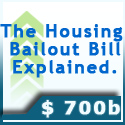Modified mortgages re-enter shadow inventory – By next month the housing crisis will have cost 5,000,000 Americans their homes via foreclosures. Distressed inventory still above 5,000,000.
If we were to take a count of how many people lost their homes to foreclosure since 2006, that figure will reach 5,000,000 by the end of the year. This is an enormous number and is rarely discussed as a historical case study in action. It is interesting how many seem to ignore this grim figure and pretend that it never happened. So keep in mind the turmoil those 5,000,000 completed foreclosures have had on the overall housing market. Will the current shadow inventory impact the current upward trend in housing? Banks are selling into some fierce momentum but things are still tepid with the overall economy. Most importantly, household income growth is nowhere to be found. Completed bank repossessions are still running at about 50,000 per month and foreclosure starts are still close to 100,000. This housing bounce as we have mentioned is coming from a trifecta of low interest rates, Wall Street investors, and foreign money. I think it is useful to take a look at where we were and where things are heading.
Posted in: banking,foreclosures,housing-data,market analysis,shadow inventory
A Tale of Two California Markets – Culver City and California City. Culver City prices back near peak levels with flippers out in full force. California City seeing prices back to levels last seen in the 1990s.
Desirable areas in Los Angeles County are finding bidding wars and many places are selling for prices last seen during the peak of the bubble. A fierce competition between flippers, foreign money, and households with healthy incomes leveraging low mortgage rates are pushing prices higher. A few readers were sending over some of the recent action taking place in Culver City. A few recounted their tales of open houses and the sense of urgency to purchase a property. The flood of easy money has certainly had an impact on mid-tier and prime locations. Only a two hour drive up north, in California City you can find homes selling for rock bottom prices. This is a trend bearing out in income statistics. It is becoming harder for the middle class to find affordable housing in California. Some have mentioned in zombie like fashion that some areas are becoming fortresses while other areas are left struggling. Let us take a look at some recent data.
Posted in: California Love,california-equity-giants,housing-data,market analysis,Price Check,southern-california-housing
Baby booming into real estate investing – 8 Charts Highlighting the Real Estate Plans of Baby Boomers. Will Older Americans Venture into Real Estate Investing?
The rush into investment real estate has largely been dominated by big pools of money and foreign investment. I’m intrigued by seeing the Wall Street machine suddenly finding blue collar rental real estate as an attractive investment. However there has been another group of potential real estate investors that has largely been hidden from view. Are baby boomers diving into the real estate investment game? The prospect of buying investment real estate has never been a popular one. Most Americans own their own home but that is largely it. Real estate in the form of investment properties is largely an active venture. Sure, some can pay a property manager to manage their asset but this will then require a diligent process in selecting a trustworthy team. The big dive by Wall Street funds into residential real estate is interesting because this is not a quick buck industry. Baby boomers with low yields on fixed income might be looking into buying other real estate as an investment or hedge. Instead of speculating on this I decided to dig deep on what baby boomers are doing when it comes to other real estate outside of their primary residence.
Posted in: baby-boomers,banking,debt,flipping,housing valuation
Real Homes of Genius – A home for less than $100,000 in Los Angeles? The attraction of being a landlord.
We are back to the days where low priced homes in Los Angeles County are a rare commodity. Yet those homes are out there for a variety of reasons. It is amazing how pervasive the flipper mentality is out here in good old SoCal. Everything is just a matter of a few HGTV remodeling techniques and then you are off to the big money races. Put aside your feelings for schools, quality of the structure, crime, or even if you would like to live in the area. So today we ran across a home that is under $100,000 in Los Angeles that is currently listed for sale. A sub-$100k property in Los Angeles? How can that be? Are we not living through mania 2.0? Today we salute you Los Angeles with our Real Homes of Genius Award.
Posted in: california-equity-giants,housing-data,market analysis,Price Check,real-estate,real-homes-of-genius,southern-california-housing
 Subscribe to feed
Subscribe to feed





Blogroll
- Bull! Not Bull!
- Calculated Risk
- Clive Maund
- Commonsense Forecaster
- Daneric's Elliott Waves
- *Dollar Collapse
- Economist's View
- FallStreet
- Fiend SuperBear
- Finance my Money
- Financial Sense
- Foreclosure.com
- Jesse's Cafe Americain
- Max Keiser
- My Budget 360
- Itulip.com
- Robb Wolf - Paleo The Mess That Greenspan Made
- The Burning Platform
- Of Two Minds
- SteveQuayle.com
- Survival Blog
- W.C. Varones Blog
- Zero Hedge
- Preppers : TheSurvivalistBlog.net
- Bay Area RE Trends
- Bubble Meter
- History of a Housing Bubble - LA Times Archive From Previous Housing Bubble
- Irvine Housing Blog
- Long Beach RE Blog
- OChousingnews
- Patrick.net
- Piggington's Econo-Almanac (San Diego Info)
- Sacramento Land(ing)
- WestsideREmeltdown
- Countrywide-Foreclosures Blog
- Great Depression of 2006
- House Bubble
- Housing Chronicles
- Housing Panic
- Housing Panic 2.0
- HousingTracker (Real Estate Market Stats)
- Housingwire
- *Mortgage Lender Implode-O-Meter
- Paper Economy
- Portland Housing Blog
- UK Housing Bubble
- Home Fish
- Foreclosures
- Daily Crash Report
- Loan Modification Ebook
-
Real Estate Cycles (1800 - 2005)

Life, Politics, Economics, and Wealth
California Real Estate
National Real Estate
Regional Housing Blogs
Other Housing Related Sites
Other Sites
Housing Data and Finance Blogs

